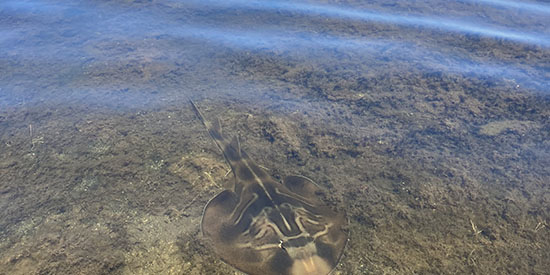Five hidden gems of Port Phillip Bay to explore these Easter holidays
Media release
If a trip to the beach is on the to do list these school holidays or over the Easter weekend, a Deakin University marine scientist recommends venturing beyond the usual swimming spots to explore the wonders of our coastal wetlands.
Dr Paul Carnell is a research fellow within the Deakin MARINE group based at the Queenscliff Marine Science Centre and has been researching the coastal wetlands and kelp forests around Port Phillip Bay. He says that the bay’s coastline has a lot to offer beyond the sand and surf.
"When planning a trip to the beach, our first thought is usually the surf and swimming beaches that we are so fortunate to have along our coastlines," Dr Carnell said.
"What people may not be aware of are the coastal wetlands that sit as hidden gems around Port Phillip Bay.
"These seagrass beds, mangrove forests and saltmarshes are havens for wildlife and provide great locations for a range of recreational activities such as fishing, snorkelling, bike riding, bird watching, walks and picnics."
Dr Carnell said the coastal wetlands are not only great for entertaining the kids and the weekend recreational explorer, they provide food and habitat for a range of wildlife and play an important role in addressing the impact of climate change.
"Our research has shown the environmental and economic benefits of these ecosystems as habitat for birds, nursery grounds for the fish caught by commercial and recreational fishers as well reducing coastal erosion and wave damage," he said.
"They are also our most powerful tool to address climate change as they act as carbon sinks, trapping carbon to reduce CO2 concentrations in the atmosphere at rates 20-40 times greater than our forests."
Here Dr Carnell shares his top five coastal wetlands in Port Phillip Bay to explore:
Mud Islands
"A lot of people might not know that this series of islands exists in the middle of the bay.
"While it is called Mud Islands, which might not sound enticing, the perimeter is beautiful sandy beaches, great for swimming, picnics and wildlife spotting.
"The kids will love exploring the seagrass beds and mud flats that provide safe nesting places for fairy terns, pelicans and swans, and the crabs that live in the sand.
"I had the opportunity to go there for the first time recently and was blown away by its beauty and the bird life nesting in the vegetation.
"You do need a boat to get there but it is well worth a visit."
Mud Islands is located approximately 10 km inside Port Phillip Heads, 7 km north of Portsea and 9 km east of Queenscliff.
Swan Bay
"Sitting between Queenscliff and St Leonards on the Bellarine Peninsula, Swan Bay is a beautiful environment to explore.
"Very quickly you realise why it was called Swan Bay. On some days, hundreds of Black Swans can be seen feeding or resting here in the shallow protected waters. Swan Bay is also a place many resident and migratory birds can be spotted, including red-capped plovers, Terns, Egret’s, Spoonbills and if you want to have a go at snorkelling there are plenty of fish to see from fiddler rays and flat head to whiting and squid.
"Edwards Point Wildlife Reserve on the northern shores of Swan Bay, is one of my favourite walks on the Bellarine, with one of the largest areas of coastal woodlands in the area, along with amazing views across both Swan Bay and Port Phillip.
"The Marine and Freshwater Discovery Centre is also worth a visit or come say hi to me in the neighbouring Deakin MARINE Science Centre."
Jawbone Marine Sanctuary
"There is plenty to do in this sanctuary that sits right on Melbourne’s doorstep.
"This is the best snorkelling you can do so close to Melbourne. And if getting in the water isn’t your thing, there are plenty of coastal walking tracks and bike paths.
"Or if you prefer a slower pace, head into the wetland area and walk along the saltmarsh boardwalk, where you can spot a variety of birds."
Jawbone Marine Sanctuary is on the south western shoreline of Williamstown.
Rickets Point Marine Sanctuary
"This sanctuary is great for walking, bike riding, swimming and snorkelling. Take a picnic for the beach or make the most of the café right next door.
"There are sandstone reefs occupied by the habitat forming kelp, as well as sea caves and rockpools to explore for sea creatures.
"And if snorkelling you will likely see zebrafish and a friendly Port Jackson Shark (the pugs of the ocean) hanging out in among the kelp."
Rickets Point is near Beaumaris in Melbourne’s south east
Limeburners Bay Wildlife Reserve
"When travelling on the highway from Melbourne to Geelong many people would not know that they are driving past this little pocket of marine paradise.
"This protected lagoon is home to mangrove forests down on the water’s edge, with a fabulous boardwalk that takes you up close and personal. Here you will see all the crabs and birds that call this wetland haven their home.
"There are also great paths for bike riding and walking, so bring along a picnic and it will be a great day out for the whole family.
"The protected lagoon is also perfect for stand-up paddleboards or kayaking, and even throwing in a line where you might be able to catch some flathead, whiting or snapper."
Limeburners Bay is located on the northern shore of Corio Bay near Geelong Grammar School.
Share this story

